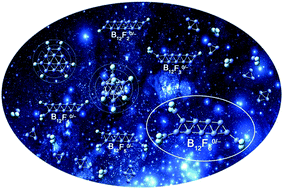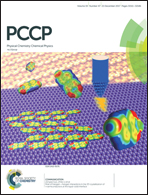B12Fn0/− (n = 1–6) series: when do boron double chain nanoribbons become global minima?†
Abstract
We present an extensive density-functional and wave function theory study of partially fluorinated B12Fn0/− (n = 1–6) series, which show that the global minima of B12Fn0/− (n = 2–6) are characterized to encompass a central boron double chain (BDC) nanoribbon and form stable BF2 groups at the corresponding BDC corner when n ≥ 3, but the B12F0/− system maintains the structural feature of the well-known quasi-planar C3v B12. When we put the spotlight on B12F60/− species, our single-point CCSD(T) results unveil that albeit with the 3D icosahedral isomers not being their global minima, C2 B12F6 (6.1, 1A) and C1 B12F6− (12.1, 2A) as typical low-lying isomers are 0.60 and 1.95 eV more stable than their 2D planar counterparts D3h B12F6 (6.7, 1A′) and C2v B12F6− (12.7, 2A2), respectively, alike to B12H60/− species in our previous work. Detailed bonding analyses suggest that B12Fn0/− (n = 2–5) possess ribbon aromaticity with σ plus π double conjugation along the BDC nanoribbon on account of their total number of σ and π delocalized electrons conforming the common electron configuration (π2(n+1)σ2n). Furthermore, the simulated PES spectra of the global minima of B12Fn− (n = 1–6) monoanions may facilitate their experimental characterization in the foreseeable future. Our work provides new examples for ribbon aromaticity and powerful support for the F/H/Au/BO analogy.



 Please wait while we load your content...
Please wait while we load your content...